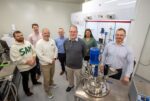Deakin REACH and Samsara Eco unite to transform textile recycling with world-leading enzyme technology
Australia’s war on waste has a powerful new ally, Deakin University’s Recycling and Clean Energy Commercialisation Hub (REACH). REACH has joined forces with Samsara Eco to fast-track world-first technology that could recycle plastics and textiles, previously considered unrecyclable, that would take centuries to eliminate from the environment. Textile waste is one of the world’s most persistent environmental issues, driven by fast fashion, high consumption and poor disposal practices. In Australia, synthetic fibres like nylon and polyester make up almost 60 per cent of the materials used in clothing, yet with less than one per cent of discarded garments recycled into new clothes, most end up in landfill or are incinerated, adding to pollution and harmful emissions. Samsara Eco’s AI-designed enzymes break down fossil-fuel derived materials like synthetic fibres, including nylon 6,6 and polyethylene terephthalate (PET) into their original building blocks or monomers – allowing them to be rebuilt into new products with virgin-quality performance. The collaboration will see Samsara Eco lean into Deakin’s advanced chemical analysis and polymer processing expertise to better understand and find recycling solutions for specific additives like dyes, finishes and coatings present in textile waste. ‘We are laser-focused on creating true circularity and that means finding a solve for all plastics,’ said Founder and CEO at Samsara Eco Paul Riley. ‘This research supports our efforts to make this a reality. We’ve already come a long way with our enzymatic recycling technology, which can infinitely recycle PET and nylon 6,6 plastics used for clothing and other textiles, including mixed fibres and plastics. Our research collaboration with Deakin will support our efforts to recycle more waste at speed, scale and with precision.’ Unlike mechanical recycling, which degrades the quality of materials and limits recyclability, Samsara Eco’s enzymatic depolymerisation technology is making it possible to rebuild worn or contaminated textiles into […]









